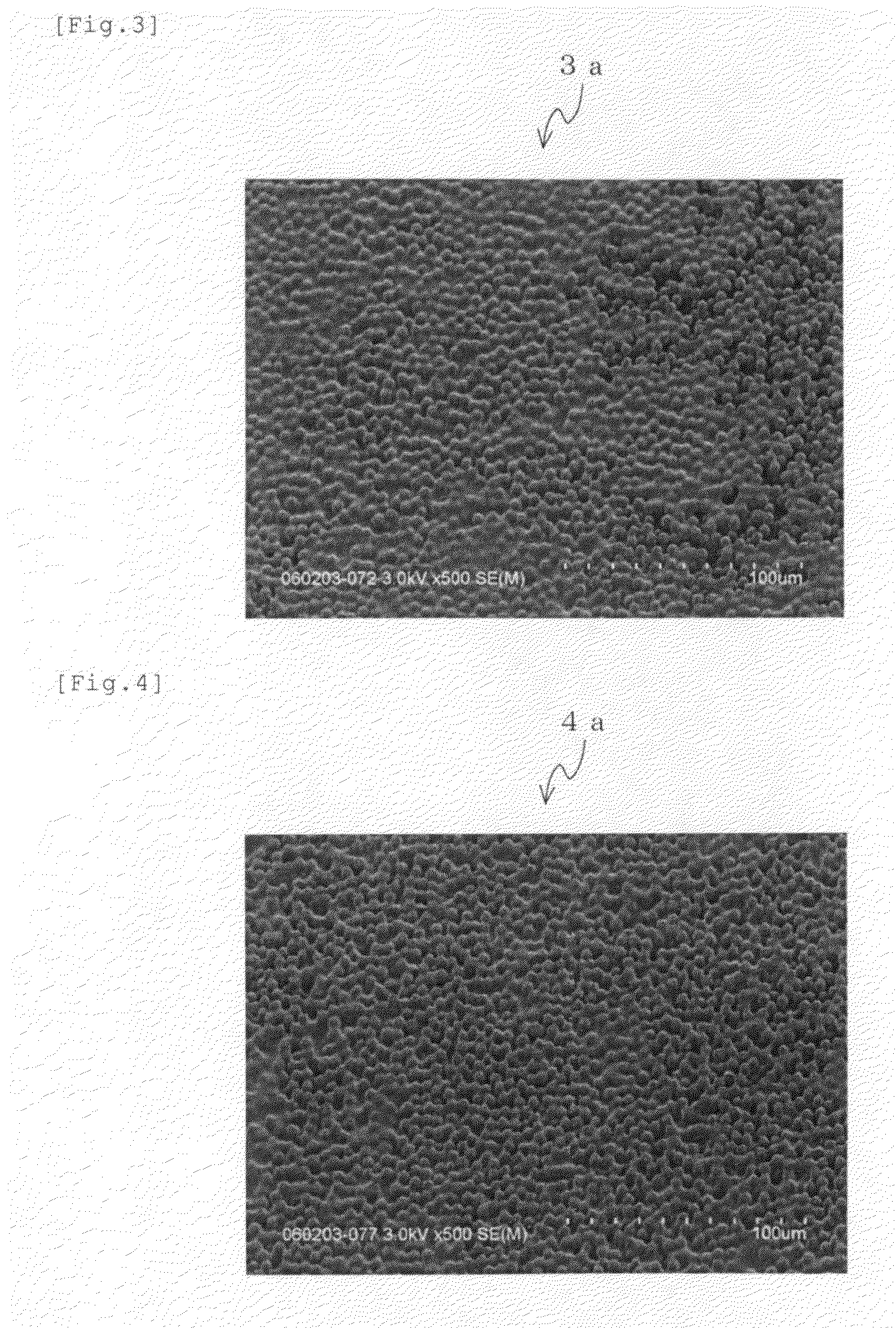Polymer articles with Polymer layer containing incompatible material unevenly distributed and surface-roughened tape or sheet comprising the polymer articles
a polymer article and polymer layer technology, applied in the direction of film/foil adhesives, synthetic resin layered products, transportation and packaging, etc., can solve the problems of difficult application of solution to the base surface, unsuitable for the formation of roughened surfaces by the action of particles, and difficult to employ this technique. , to achieve the effect of superior adhesion
- Summary
- Abstract
- Description
- Claims
- Application Information
AI Technical Summary
Benefits of technology
Problems solved by technology
Method used
Image
Examples
preparation example 1
of Base-Supported Monomer-Absorptive Sheet
[0291]A photopolymerizable syrup composition (hereinafter also referred to as a “photopolymerizable syrup composition (A)”) was prepared by homogeneously mixing 100 parts by weight of the photopolymerizable syrup (A) with 0.1 part by weight of 1,6-hexanediol diacrylate, and the composition was applied to one side of a biaxially oriented poly(ethylene terephthalate) film 38 μm thick, to form a layer of photopolymerizable syrup composition that would have a thickness after curing of 300 μm. Next, the layer was laminated to the releasable surface of the cover film and then cured by applying an ultraviolet ray at an intensity of 5 mW / cm2 for three minutes using a black-light lamp to form a monomer-absorptive layer. Thus there was prepared a base-supported monomer-absorptive sheet whose monomer-absorptive layer was protected on its surface by the cover film (hereinafter also referred to as a “base-supported monomer-absorptive sheet (A)”).
preparation example 2
of Base-Supported Monomer-Absorptive Sheet
[0292]A photopolymerizable syrup composition (hereinafter also referred to as a “photopolymerizable syrup composition (B)”) was prepared by homogeneously mixing 100 parts by weight of the photopolymerizable syrup (B) with 0.1 part by weight of 1,6-hexanediol diacrylate, and the composition was applied to one side of a biaxially oriented poly(ethylene terephthalate) film 38 μm thick, to form a layer of photopolymerizable syrup composition that would have a thickness after curing of 75 μm. Next, the layer was laminated to the releasable surface of the cover film and then cured by applying an ultraviolet ray at an intensity of 5 mW / cm2 for three minutes using a black-light lamp to form a monomer-absorptive layer. Thus there was prepared a base-supported monomer-absorptive sheet whose monomer-absorptive layer was protected on its surface by the cover film (hereinafter also referred to as a “base-supported monomer-absorptive sheet (B)”).
preparation example 3
of Base-Supported Monomer-Absorptive Sheet
[0293]A photopolymerizable syrup composition (hereinafter also referred to as a “photopolymerizable syrup composition (C)”) was prepared by homogeneously mixing 100 parts by weight of the photopolymerizable syrup (C) with 0.1 part by weight of 1,6-hexanediol diacrylate, and the composition was applied to one side of a biaxially oriented poly(ethylene terephthalate) film 38 μm thick, to form a layer of photopolymerizable syrup composition that would have a thickness after curing of 75 μm. Next, the layer was laminated to the releasable surface of the cover film and then cured by applying an ultraviolet ray at an intensity of 5 mW / cm2 for three minutes using a black-light lamp to form a monomer-absorptive layer. Thus there was prepared a base-supported monomer-absorptive sheet whose monomer-absorptive layer was protected on its surface by the cover film (hereinafter also referred to as a “base-supported monomer-absorptive sheet (C)”).
PUM
| Property | Measurement | Unit |
|---|---|---|
| diameter | aaaaa | aaaaa |
| length | aaaaa | aaaaa |
| thick | aaaaa | aaaaa |
Abstract
Description
Claims
Application Information
 Login to View More
Login to View More - R&D
- Intellectual Property
- Life Sciences
- Materials
- Tech Scout
- Unparalleled Data Quality
- Higher Quality Content
- 60% Fewer Hallucinations
Browse by: Latest US Patents, China's latest patents, Technical Efficacy Thesaurus, Application Domain, Technology Topic, Popular Technical Reports.
© 2025 PatSnap. All rights reserved.Legal|Privacy policy|Modern Slavery Act Transparency Statement|Sitemap|About US| Contact US: help@patsnap.com



